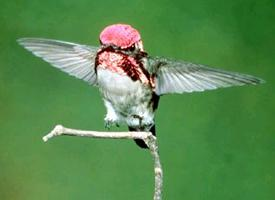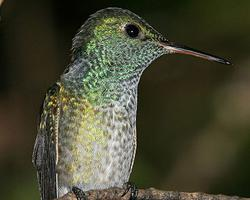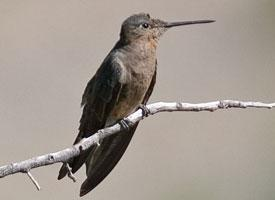
Poids et mesures
| Longueur | de 5.51 à 6.12 cm |
|---|---|
| Poids | 1,95 g |
| Envergure des ailes | 3,25 cm |
Description de l'animal
The Bee Hummingbird (Mellisuga helenae), often celebrated as the world's smallest bird, is an enchanting species native to Cuba and the Isla de la Juventud. This diminutive bird, with its remarkable features and behaviors, captivates the hearts of birdwatchers and nature enthusiasts alike. Measuring a mere 5 to 6 cm in length and weighing around 1.6 to 2 grams, the Bee Hummingbird is comparable in size to a large bee, which is how it earns its name.The male Bee Hummingbird showcases a dazzling array of colors; his plumage is iridescent, with the head and throat (gorget) exhibiting brilliant shades of red or pink when the light hits just right, contrasting sharply with his bluish upper parts and pale grey underparts. The female, in contrast, is slightly larger and less colorful, with more subdued greenish upper parts and whitish underparts with greyish flanks, though she shares the same rapid wingbeats that make her counterpart a spectacle in flight. Both sexes have a straight, slender, and short bill, adapted perfectly for extracting nectar from flowers.
The Bee Hummingbird's habitat is primarily found in the dense forests and woodland areas of Cuba, though they are also known to inhabit garden areas and meadows where flowering plants are abundant. These birds are solitary creatures, coming together only during the breeding season. Their diet consists mainly of nectar, obtained by their remarkable hovering flight in front of flowers. This high-energy diet is supplemented by small insects and spiders, providing essential proteins.
Breeding season brings about an extraordinary effort from the male Bee Hummingbird, who performs elaborate aerial displays and vocalizations to attract a mate. Once paired, the responsibility of nest-building falls upon the female, who constructs a tiny cup-shaped nest from cobwebs, bark, and lichen, securing it to a branch with spider silk. The nest, barely larger than a thimble, perfectly fits the bird's diminutive size and typically contains two pea-sized eggs, which are among the smallest bird eggs in the world.
The Bee Hummingbird's reproductive cycle is as fascinating as its size. The female solely incubates the eggs for about two weeks, and after the chicks hatch, she feeds them on a diet of nectar and insects. Within three weeks, the young are ready to leave the nest, having grown to the full size of their parents and capable of independent life.
Despite their small size, Bee Hummingbirds are remarkably resilient. They exhibit incredible agility in flight, capable of hovering in place with wingbeats so rapid they create a buzzing sound, much like that of bees. This flight capability allows them to access the nectar of flowers with precision, playing a crucial role in pollination.
However, the Bee Hummingbird faces threats from habitat loss and climate change, which impact their natural habitats and food sources. Conservation efforts are crucial to ensuring the survival of this unique species, whose existence adds to the rich tapestry of biodiversity on our planet.
In sum, the Bee Hummingbird is a marvel of nature, embodying the extraordinary diversity and adaptability of avian life. Its existence is a reminder of the intricate connections within ecosystems and the importance of preserving natural habitats for the smallest among us.
Animaux similaires
Nouvelles photos d'animaux
Top 10 des animaux
- Dolphin gull (Leucophaeus scoresbii)
- Diana monkey (Cercopithecus diana)
- Moustached guenon (Cercopithecus cephus)
- Galápagos tortoise (Geochelone nigra complex)
- Japanese macaque (Macaca fuscata)
- Russian tortoise (Testudo horsfieldii)
- Stone loach (Barbatula barbatula)
- Greek tortoise (Testudo graeca)
- Common flying dragon (Draco volans)
- Vendace (Coregonus albula)

